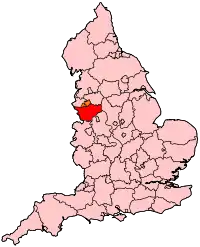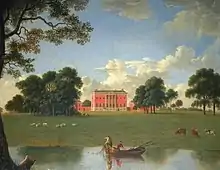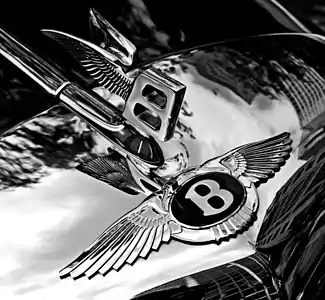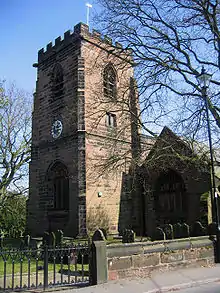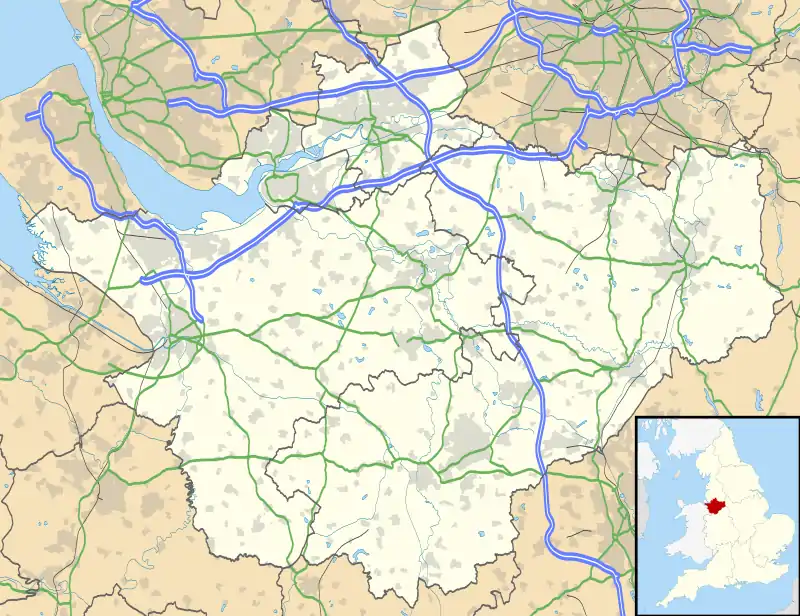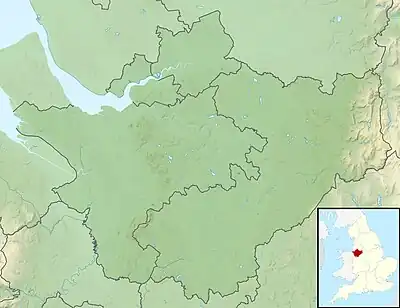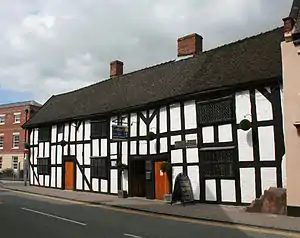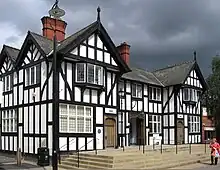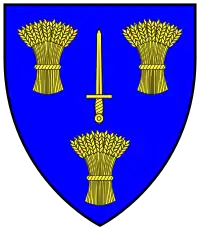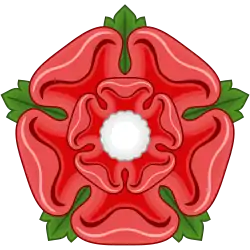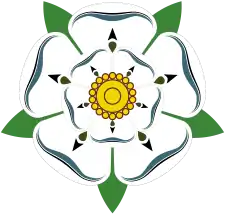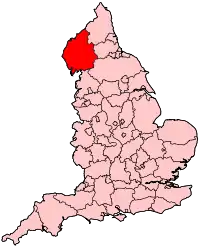|
The Cheshire Portal
WelcomeCheshire Plain from the Mid Cheshire Ridge
Cheshire is a ceremonial county in the North West of England. Chester is the county town, and formerly gave its name to the county. The largest town is Warrington, and other major towns include Congleton, Crewe, Ellesmere Port, Macclesfield, Nantwich, Northwich, Runcorn, Sandbach, Widnes, Wilmslow and Winsford. The county is administered as four unitary authorities. Cheshire occupies a boulder clay plain (pictured) which separates the hills of North Wales from the Peak District of Derbyshire. The county covers an area of 2,343 km2 (905 sq mi), with a high point of 559 m (1,834 ft) elevation. The estimated population is a little over one million, 19th highest in England, with a population density of around 450 people per km2. The county was created in around 920, but the area has a long history of human occupation dating back to before the last Ice Age. Deva was a major Roman fort, and Cheshire played an important part in the Civil War. Predominantly rural, the county is historically famous for the production of Cheshire cheese, salt and silk. During the 19th century, towns in the north of the county were pioneers of the chemical industry, while Crewe became a major railway junction and engineering facility. Selected article
Tabley House is a grade-I-listed country house in Tabley Inferior, near Knutsford. It was built by John Carr in the Palladian style for Sir Peter Byrne Leicester. Completed in around 1769, it is the only Palladian country house in Cheshire to date from the 18th century. The house is in brick with stone dressings, and has a large sandstone portico on the south front and paired pavilion wings. Tabley House replaced Tabley Old Hall of around 1380, located on a moated island, which Sir Peter deemed "not commodious." The ruins of the Old Hall remain in the grounds. Its chapel, now known as St Peter's Church, was moved to stand by the new house in 1927. The house and estate continued to be held by the Leicester family until 1975, and subsequently belonged to the Victoria University of Manchester. The first-floor reception rooms are now open to the public and display paintings and furniture from the house. Selected image
The Bentley Crewe plant in Crewe opened in 1938, manufacturing Rolls-Royce Merlin aircraft engines during the Second World War. Bentley cars have been made there since 1946. Credit: Dan Smith (October 2005) In this month
1 January 1894: Manchester Ship Canal first opened to traffic. 2 January 1644: Dorfold Hall taken by Royalist forces during the Civil War. 3 January 1866: Crewe Hall gutted by fire. 13 January 1984: A cooling tower at Fiddlers Ferry Power Station (pictured) collapsed in high winds. 17 January 1644: Royalist forces attacked Nantwich during the Civil War. 20 January 1540: Dissolution of St Werburgh's Abbey. 20 January 1971: Singer–songwriter Gary Barlow born in Frodsham. 24 January 1909: Film star Ann Todd born in Hartford. 25 January 1837: Fire damaged the new wing of Vale Royal Abbey. 26 January 1644: Battle of Nantwich. 27 January 1832: Author and mathematician Lewis Carroll born in Daresbury. 27 January 1941: Cosmologist Beatrice Tinsley born in Chester. 28 January 1643: First battle of Nantwich. Selected list
The 27 listed buildings in Runcorn rural area include three at Grade II* and 24 at Grade II. In contrast to the Runcorn urban area, the surrounding borough contains small villages – Clifton, Daresbury, Moore, Preston Brook and Preston on the Hill – which have experienced only limited population growth since the Industrial Revolution, and are still separated by farmland and woodland. The oldest listed structure is the ruin of Clifton Hall, built in 1565. The three Grade II* listed buildings are All Saints' Church, Daresbury (pictured), dating originally from the 16th century, and two 18th-century former mansion houses, Daresbury Hall and Moore Hall. Many of the structures are related to the network of canals in the area, with several canal bridges, including a swing bridge over the Manchester Ship Canal, a former warehouse, a tunnel entrance, a milepost and two air shafts, as well as a railway viaduct crossing the Weaver Navigation. Other listed buildings include a public house, a former school and a former sessions house, as well as several farmhouses and cottages. The most recent listed structure is a K6-type telephone kiosk dating from the 1930s. GeographyTop: Map of modern Cheshire showing urban areas (grey) and the major road network. Chester (red) is the county town, and Warrington has the greatest population. Towns with more than 10,000 inhabitants in 2011 are highlighted; the size of dot gives a rough indication of the relative population. Wales and the adjacent English counties are shown in capitals. Bottom: Relief map showing the major hills. The Mid Cheshire Ridge is a discontinuous ridge of low hills running north–south from Beacon Hill (north of Helsby Hill) to Bickerton Hill. Most other high ground falls within the Peak District in the east of the county. Shining Tor (559 metres), on the boundary with Derbyshire, forms the county's high point. Administration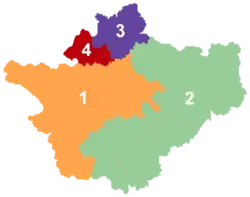 The ceremonial county of Cheshire is administered by four unitary authorities (click on the map for details): 2 – Cheshire East 3 – Warrington 4 – Halton In the local government reorganisation of 1974, Cheshire gained an area formerly in Lancashire including Widnes and Warrington. The county lost Tintwistle to Derbyshire, part of the Wirral Peninsula to Merseyside, and a northern area including Stockport, Altrincham, Sale, Hyde, Dukinfield and Stalybridge to Greater Manchester. Selected biography
Michael James Owen (born 14 December 1979) is a former English football player who played as a striker. Born in Chester, his father Terry Owen was a professional footballer who played for Chester City and Everton. Owen enjoyed a hugely successful and high-profile career at both club and international level, and in 2001 became one of a handful of English players to win the Ballon d'Or. As of 2019, he is fifth in the list of all-time top scorers for the England team and is England's eleventh most-capped player, having scored 26 competitive goals – formerly a national record – with 40 in total from 89 appearances (1998–2008). Pace and clinical finishing were Owen's greatest assets early in his career, though he later lost pace due to injuries. In club football, he played for Liverpool (1996–2004), Real Madrid (2004–5), Newcastle United (2005–9), Manchester United (2009–12) and Stoke City (2012–13). He retired from football in 2013. He has subsequently owned and bred racehorses, and acts as a sports commentator and pundit. Did you know...
Selected town or village
Northwich, the most northerly of Cheshire's wich towns, lies at the confluence of the rivers Weaver and Dane, near Winsford, in the heart of the Cheshire Plain. The population of the civil parish was nearly 20,000 in 2011. Northwich rests on Lower Keuper saliferous beds. The settlement – then called Condate, thought to mean "confluence" – has been known since the Roman era, when it was important as a river crossing and a source of salt, and the area has long been exploited for its salt pans. The town has had a market since at least 1535. From the 19th century, pumped water was used to extract salt as brine, leading to subsidence problems and the creation of flashes. Several buildings were designed to be lifted in the event of subsidence. Northwich has been involved in the chemical industry since 1874, when Brunner Mond, later part of ICI, started to manufacture soda ash in Winnington. The mines were stabilised in the early 2000s, and much of the industrial area has been reclaimed to form Northwich Woodlands. The Weaver Hall Museum documents the town's salt industry. In the news.JPG.webp) Crewe Market Hall 29 October, 1 November: Warrington council and the mayor of Crewe each announce plans to bid for city status in 2022. 13–14 October: Prince Edward visits Chester and opens a Fire Service training centre in Winsford. 8 October: Castle Street shopping area in Macclesfield reopens after refurbishment. 4 October: Restoration of the grade-I-listed Bridgegate, part of Chester city walls, is completed. 25 September: A bronze frieze by the sculptor Tom Murphy is unveiled in Warrington, as a memorial to the band Viola Beach. 9 September: The fifth stage of the Tour of Britain cycle race takes place in Cheshire, starting at Alderley Park and finishing in Warrington. 24 July: The grade-II-listed Crewe Market Hall (pictured) formally reopens after refurbishment. 15 July: Crewe, Runcorn and Warrington are awarded potential funding under the "Town Deal" government scheme. QuotationBefore the advent of the London and North Western and the establishment of its works there was no Crewe. Let the London and North Western depart tomorrow, and Crewe would perish out of the list of living towns as completely as Nineveh or Pompeii. The grass would grow in its streets, its houses would stand in empty rows, its churches would become nesting places for the rooks and owls, its people would fly from it; and pasture fields for sheep and oxen, dotted with, perhaps, half a dozen peasant homesteads, would take the place of one of the most progressive and flourishing towns of modern England. From "The King of Crewe" in Crewe Chronicle (1902)
Subcategories
TopicsRecommended articles.svg.png.webp) Things you can do
WikiProject Map of Cheshire WikiProject Cheshire There are 3,537 articles in the project's scope Related WikiProjects UK Geography • England Greater Manchester • Lancashire and Cumbria • Merseyside • YorkshireRelated portalsAssociated WikimediaThe following Wikimedia Foundation sister projects provide more on this subject:
Discover Wikipedia using portals
|

